General purpose plasticizers based on naphthalic acid diesters
Cohn , et al. Feb
U.S. patent number 10,570,084 [Application Number 15/802,980] was granted by the patent office on 2020-02-25 for general purpose plasticizers based on naphthalic acid diesters. This patent grant is currently assigned to EXXONMOBIL RESEARCH AND ENGINEERING COMPANY. The grantee listed for this patent is ExxonMobil Research and Engineering Company. Invention is credited to Stephen T. Cohn, Christine A. Costello, Christopher M. Evans, James R. Lattner.
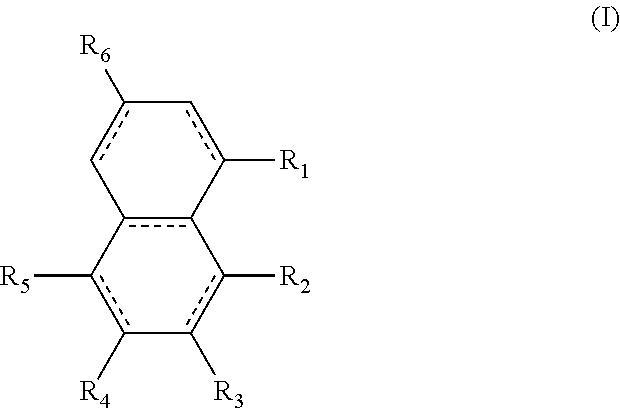
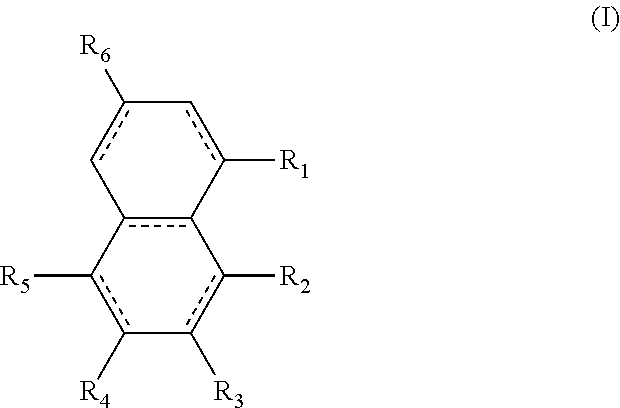
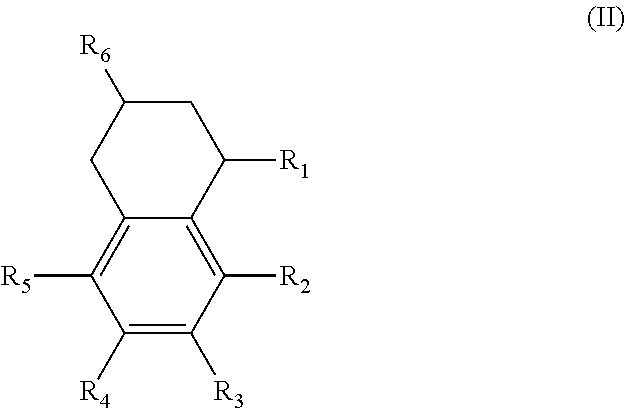
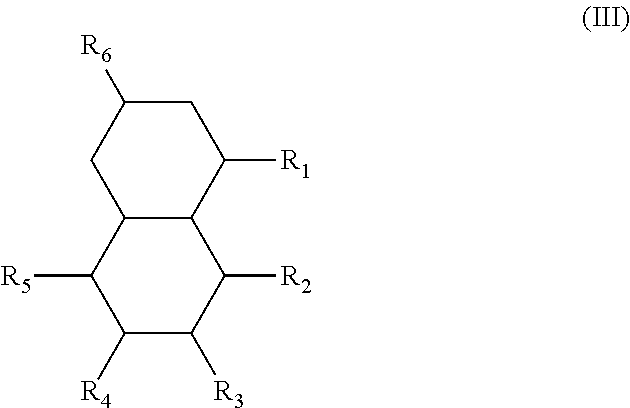
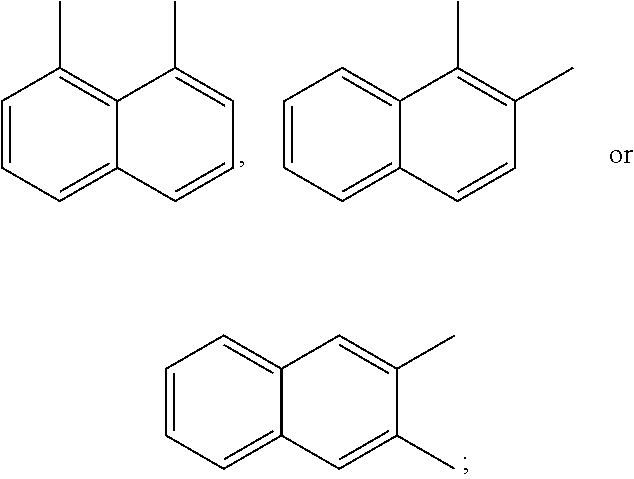
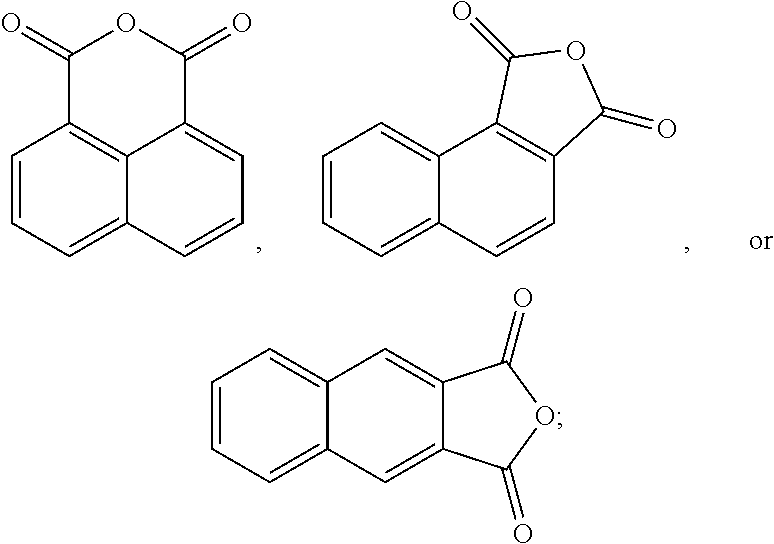

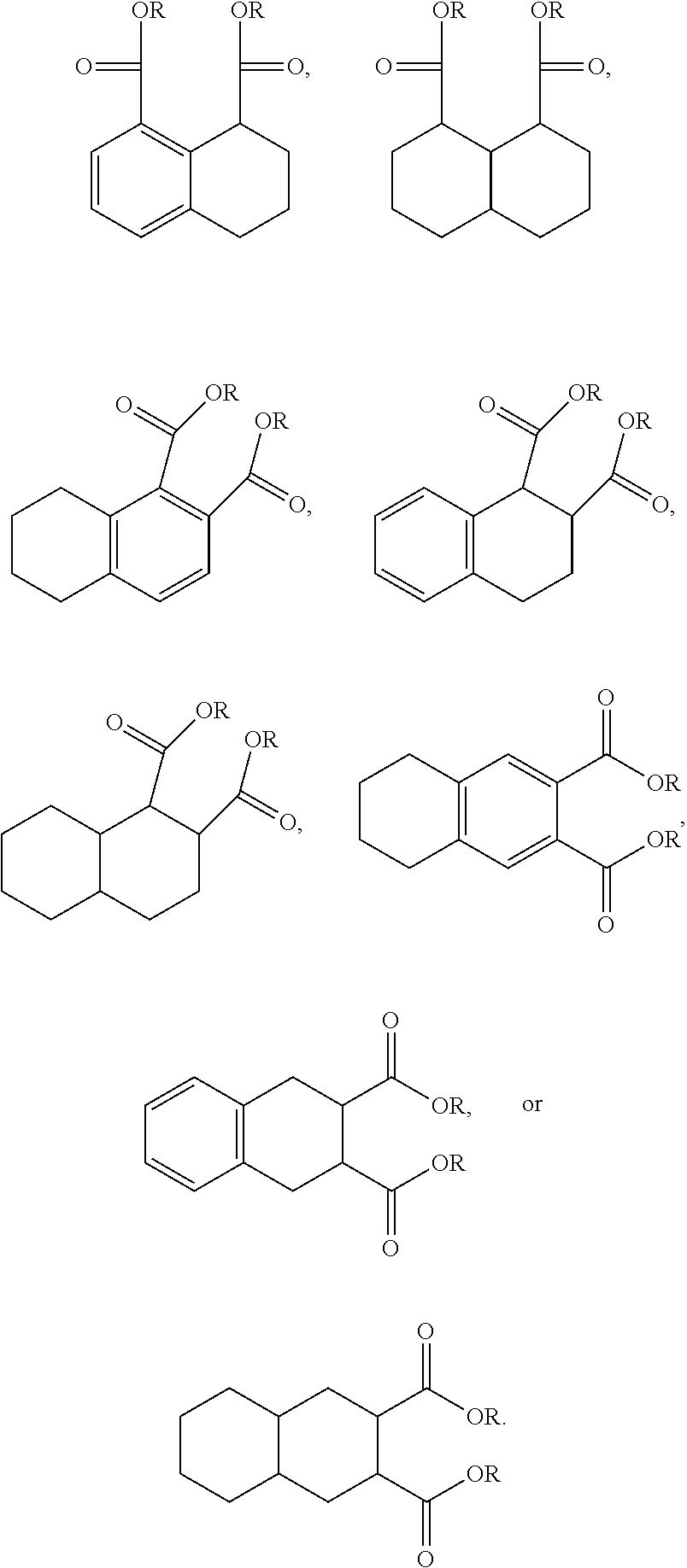

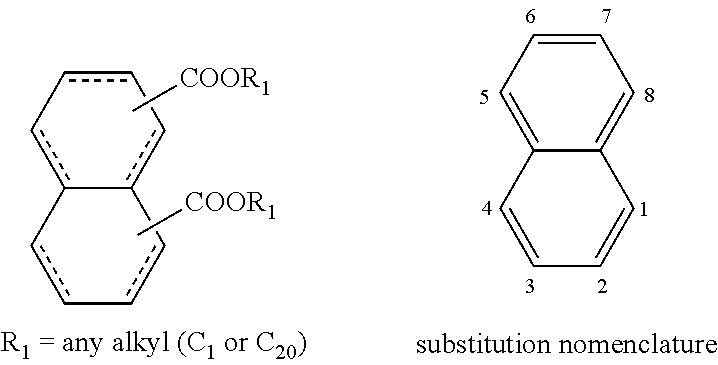

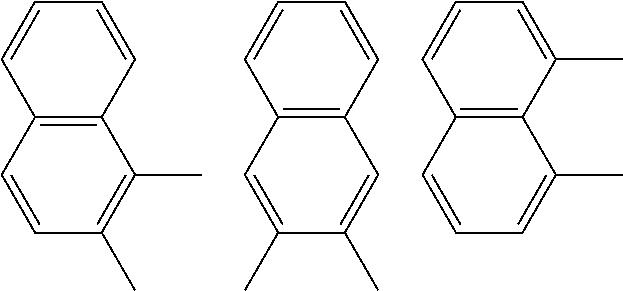
View All Diagrams
| United States Patent | 10,570,084 |
| Cohn , et al. | February 25, 2020 |
General purpose plasticizers based on naphthalic acid diesters
Abstract
A diester of a fused ring compound of the formula (I): ##STR00001## wherein: the fused rings are both aromatic; R1 and R4 to R6 substituents are H or ester moieties having C1 to C20 linear or branched alkyl chains; R2 and R3 are --C(O)OCxHy, wherein x is from 10 to 12 and y is from 21 to 25; two adjacent R1 to R4 substituents are --C(O)OCxHy, wherein x is from 10 to 12 and y is from 21 to 25; and when R3 and R4 are ester moieties, the alkyl chains of R4 are not C5 or C8; and polymer compositions containing the fused ring compound.
| Inventors: | Cohn; Stephen T. (Spring, TX), Evans; Christopher M. (Kenmore, NY), Costello; Christine A. (Easton, PA), Lattner; James R. (LaPorte, TX) | ||||||||||
|---|---|---|---|---|---|---|---|---|---|---|---|
| Applicant: |
|
||||||||||
| Assignee: | EXXONMOBIL RESEARCH AND ENGINEERING
COMPANY (Annandale, NJ) |
||||||||||
| Family ID: | 62020250 | ||||||||||
| Appl. No.: | 15/802,980 | ||||||||||
| Filed: | November 3, 2017 |
Prior Publication Data
| Document Identifier | Publication Date | |
|---|---|---|
| US 20180118660 A1 | May 3, 2018 | |
Related U.S. Patent Documents
| Application Number | Filing Date | Patent Number | Issue Date | ||
|---|---|---|---|---|---|
| 62438495 | Dec 23, 2016 | ||||
| 62416944 | Nov 3, 2016 | ||||
| Current U.S. Class: | 1/1 |
| Current CPC Class: | C08K 5/12 (20130101); C08K 5/0016 (20130101); C07C 67/08 (20130101); C07C 69/76 (20130101); C07C 67/12 (20130101); C08K 5/09 (20130101); C07C 69/616 (20130101); C07C 69/753 (20130101); C07C 67/303 (20130101); C08F 14/06 (20130101); C07C 67/08 (20130101); C07C 69/76 (20130101); C07C 67/12 (20130101); C07C 69/76 (20130101); C07C 67/303 (20130101); C07C 69/76 (20130101); C07C 67/303 (20130101); C07C 69/753 (20130101); C08K 5/12 (20130101); C08L 27/06 (20130101); G01R 33/46 (20130101); C07D 307/92 (20130101); C08L 33/10 (20130101); C08L 27/06 (20130101); C07C 2602/10 (20170501); C08L 75/04 (20130101); C08L 23/0853 (20130101); C07C 2602/28 (20170501) |
| Current International Class: | C07C 67/08 (20060101); C07C 69/616 (20060101); C08K 5/00 (20060101); C07C 69/76 (20060101); C08K 5/12 (20060101); C07C 67/12 (20060101); C07C 69/753 (20060101); C07C 67/303 (20060101); C08F 14/06 (20060101); C08K 5/09 (20060101); C07D 307/92 (20060101); C08L 33/10 (20060101); C08L 27/06 (20060101); C08L 23/08 (20060101); G01R 33/46 (20060101); C08L 75/04 (20060101) |
References Cited [Referenced By]
U.S. Patent Documents
| 1909092 | May 1933 | Bruson |
| 2233513 | March 1941 | Bruson |
| 2372947 | April 1945 | Gresham |
| 2512675 | June 1950 | Michel et al. |
| 3110724 | November 1963 | Woodbridge et al. |
| 3218277 | November 1965 | Ringwald et al. |
| 3239363 | March 1966 | Burdge |
| 3255235 | June 1966 | Coran et al. |
| 3284220 | November 1966 | Anaguostopoulos et al. |
| 3517053 | June 1970 | Antonsen |
| 3624133 | November 1971 | Reitsema et al. |
| 3719466 | March 1973 | Ahle |
| 3772389 | November 1973 | Lowrance |
| 5095135 | March 1992 | Yamada et al. |
| 6274756 | August 2001 | Caers et al. |
| 6482972 | November 2002 | Bahrmann et al. |
| 6740254 | May 2004 | Zhou et al. |
| 6777514 | August 2004 | Patil et al. |
| 7297738 | November 2007 | Gosse et al. |
| 7919649 | April 2011 | Compton et al. |
| 8115034 | February 2012 | Godwin et al. |
| 8476350 | July 2013 | Dakka et al. |
| 8779084 | July 2014 | Liu |
| 8859821 | October 2014 | Godwin et al. |
| 9546259 | January 2017 | Colle et al. |
| 2002/0019559 | February 2002 | Brunner et al. |
| 2006/0247461 | November 2006 | Schlosberg et al. |
| 2009/0169775 | July 2009 | Mukunoki et al. |
| 2014/0179845 | June 2014 | Dakka et al. |
| 10146847 | Apr 2003 | DE | |||
| 0450621 | Oct 1991 | EP | |||
| 1182188 | Aug 2001 | EP | |||
| 2465841 | Jun 2012 | EP | |||
| 2965906 | Jan 2016 | EP | |||
| 61126003 | Nov 1984 | JP | |||
| H1129529 | Feb 1999 | JP | |||
| 9932427 | Jul 1999 | WO | |||
| 2003029339 | Sep 2002 | WO | |||
| 2004046078 | Jun 2004 | WO | |||
Other References
|
CAS No. 1401986-54-6,STN CAS Registry, entered Oct. 24, 2012., 1 pg. (Year: 2012). cited by examiner . English translation of JPH1129529, pp. 1-18 (Year: 1999). cited by examiner . Asaoka et al., "Enantiodifferentiating Anti-Markovnikov Photoaddition of Alcohols to 1,1-Diphenylalkenes Sensitized by Chiral Naphthalenecarboxylates", J. Am. Chem. Soc. 1999, 121, 8486-8498. (Year: 1999). cited by examiner . Adkins et al., "Selective Hydrogenation of Esters Containing a Naphthalene Nucleus", J. Am. Chem. Soc., 1949, vol. 71, pp. 3528-3531. cited by applicant . Burgess et al., "Chlorotris(triphenylphosphine)-rhodium(I)", Chem. Abstr. 2008, 149, 307083. cited by applicant . Cooke, "Formation of Polycyclic Carbocycles through Metal-Halogen Exchange-Initiated Intramolecular Conjugate Addition Reactions", J. Org. Chem., 1993, vol. 58, pp. 2910-2912. cited by applicant . Francis et al., "Highly Selective Adenosine A2 Receptor Agonists in a Series of N-Alkylated 2-Aminoadenosines", J. Med. Chem., 1991, vol. 34, pp. 2570-2579. cited by applicant . Godwyn, "Plasticizers", Applied Polymer Science 21st Century, ed. Craver and Carraher, Elsevier (2000), pp. 157-175. cited by applicant . Griebler et al., Combined Application of Stable Carbon Isotope Analysis and Specific Metabolites Determination for Assessing In Situ Degradation of Aromatic Hydrocarbons in a Tar Oil-Contaminated Aquifer., Environ. Sci. Technol., 2004, vol. 38, pp. 617-631. cited by applicant . Hagishita et al., "Optical Activity in .beta..gamma.-Unsaturated Ketones. Part 2. Effect of the Magnitude and Energy of the Electric Transition Dipole Moment in the Aromatic Groups in 1- and 1,5 Substituted 9,10-Ethano-9,10-dihydroanthracen-11-one Derivatives.", J. Chem. Soc. Perkins Trans. 2, 1978, vol. 1, pp. 59-67. cited by applicant . Hunsberger et al., "The Determination of Double-bond Character in Cyclic Systems. IV. Tetrahydronaphthalene. Steric Facilitation of Chelation.", J. Am. Chem. Soc., 1958, vol. 80, pp. 3294-3300. cited by applicant . Konno et al., "Electrophilic Aromatic Substitution of Arenes with CO2 Mediated by R3SiB(C6F5)4", Chem. Letters, 2012, vol. 41., pp. 913-914. cited by applicant . Markgraf et al., "The Diels-Alder Reaction of Methyl Propiolate With 1-Vinylcycloalkenes", Tetrahedron Letters, 1983, pp. 241-244, vol. 24, Issue 3. cited by applicant . Merle-Aubry et al., "Photophysics and Photochemistry of Naphthyl Ester Polymers in Solution", Macromolecules, 1980, vol. 13, pp. 1138-1143. cited by applicant . Nemoto et al., "Beneficial Effect of TMSCI in the Lewis Acid-mediated Carboxylation of Aromatic Compounds with Carbon Dioxide", Chemistry Letters, 2006, vol. 35. pp. 820-821. cited by applicant . Newman et al., "The Catalytic Dehydrogenation of 5-Substituted 1,2,3,4-Tetrahydronaphthalene Derivatives.", J. Am. Chem. Soc., 1952, vol. 74., pp. 905-908. cited by applicant . Suga et al., "Direct carboxylation of simple arenes with CO2 through a rhodium-catalyzed C--H bond activation", Chemical Communications, 2014, vol. 50, pp. 14360-14363. cited by applicant . Yamada et al., "Asymmetric Acylations of sec-Alcohols with Twisted Amides Possessing Axial Chirality Induced by the Adjacent Asymmetric Center", J. Org. Chem., 1999, vol. 64, pp. 9365-9373. cited by applicant . Zezschwitz et al., "A One-Pot Sequence of Stille and Heck Couplings: Synthesis of Various 1,3,5-Hexatrienes and Their Subsequent 6-.pi.-Electrocyclizations", Chem. Eur. J., 2001, vol. 7 No. 18, pp. 4035-4046. cited by applicant. |
Primary Examiner: Muresan; Ana Z
Attorney, Agent or Firm: Okafor; Kristina Prasad; Priya G.
Parent Case Text
CROSS-REFERENCE TO RELATED APPLICATIONS
This application claims the benefit of U.S. Provisional Application No. 62/416,944, filed on Nov. 3, 2016, the entire contents of which are incorporated herein by reference.
This application also claims the benefit of U.S. Provisional Application No. 62/438,495, filed on Dec. 23, 2016, the entire contents of which are incorporated herein by reference.
Claims
The invention claimed is:
1. A diester of a fused ring compound of the formula (I): ##STR00033## wherein: the fused rings are both aromatic; R.sub.1 and R.sub.4 to R.sub.6 substituents are H or ester moieties having C.sub.1 to C.sub.20 linear or branched alkyl chains; R2 and R3 are --C(O)OCxHy, wherein x is from 10 to 12 and y is from 21 to 25; two adjacent R.sub.1 to R.sub.4 substituents are --C(O)OC.sub.xH.sub.y, wherein x is from 10 to 12 and y is from 21 to 25; and when R.sub.3 and R.sub.4 are ester moieties, the alkyl chains of R4 are not C.sub.5 or C.sub.8.
2. The diester of claim 1, wherein R.sub.1 is --C(O)OC.sub.xH.sub.y, wherein x is from 10 to 12 and y is from 21 to 25.
3. The diester of claim 1, wherein R.sub.2 and R.sub.5 are --C(O)OC.sub.xH.sub.y, wherein x is from 3 to 12 and y is from 7 to 25.
4. The diester of claim 1, wherein is --C(O)OC.sub.xH.sub.y, wherein x is from 3 to 12 and y is from 7 to 25.
5. A method of making a naphthalic acid based diester having adjacent ester substituents, comprising: supplying a di-substituted naphthalene of the formula: ##STR00034## oxidizing the di-substituted naphthalene to form an anhydride intermediate of the formula: ##STR00035## and esterifying the anhydride intermediate with an alcohol, ROH, wherein R is a C.sub.1 to C.sub.20 linear or branched alkyl group, to form adjacent napthalic diesters of the formula: ##STR00036##
6. The method of claim 5, further comprising hydrogenating at least one of the fused rings to form diesters of the formula: ##STR00037##
7. A polymer composition comprising a thermoplastic polymer and at least one diester of a fused ring compound of claim 1, wherein the thermoplastic polymer is selected from the group consisting of vinyl chloride resins, polyesters, polyurethanes, ethylene-vinyl acetate copolymer, rubbers, and poly(meth)acrylics.
Description
FIELD
Disclosed are diesters of fused ring compounds which find use as plasticizers for polymers.
BACKGROUND
Plasticizers are incorporated into a resin (usually a plastic or elastomer) to increase the flexibility, workability, or dispensability of the resin. The largest use of plasticizers is in the production of "plasticized" or flexible polyvinyl chloride (PVC) products. Typical uses of plasticized PVC include films, sheets, tubing, coated fabrics, wire and cable insulation and jacketing, toys, flooring materials such as vinyl sheet flooring or vinyl floor tiles, adhesives, sealants, inks, and medical products such as blood bags and tubing, and the like.
Other polymer systems that use small amounts of plasticizers include polyvinyl butyral, acrylic polymers, nylon, polyolefins, polyurethanes, and certain fluoroplastics. Plasticizers can also be used with rubber (although often these materials fall under the definition of extenders for rubber rather than plasticizers). A listing of the major plasticizers and their compatibilities with different polymer systems is provided in "Plasticizers," A. D. Godwin, in Applied Polymer Science 21st Century, edited by C. D. Craver and C. E. Carraher, Elsevier (2000); pp. 157-175.
Plasticizers can be characterized on the basis of their chemical structure. The most important chemical class of plasticizers is phthalic acid esters, which accounted for 85% worldwide of PVC plasticizer usage in 2002. However, in the recent past there has been an effort to decrease the use of phthalate esters as plasticizers in PVC, particularly in end uses where the product contacts food, such as bottle cap liners and sealants, medical and food films, or for medical examination gloves, blood bags, and IV delivery systems, flexible tubing, or for toys, and the like. For these and most other uses of plasticized polymer systems, however, a successful substitute for phthalate esters has heretofore not materialized.
One such suggested substitute for phthalates are esters based on cyclohexanoic acid. In the late 1990's and early 2000's, various compositions based on cyclohexanoate, cyclohexanedioates, and cyclohexanepolyoate esters were said to be useful for a range of goods from semi-rigid to highly flexible materials.
Other suggested substitutes include esters based on benzoic acid and polyketones. Epoxidized soybean oil, which has much longer alkyl groups (C.sub.16 to C.sub.18) has been tried as a plasticizer, but is generally used as a PVC stabilizer. Stabilizers are used in much lower concentrations than plasticizers. Additionally suggested are triglycerides with a total carbon number of the triester groups between 20 and 25, produced by esterification of glycerol with a combination of acids derived from the hydroformylation and subsequent oxidation of C.sub.3 to C.sub.9 olefins, having excellent compatibility with a wide variety of resins and that can be made with a high throughput.
However, additional plasticizers which have excellent compatibility with commonly plasticized polymers are still being sought to replace phthalate esters.
SUMMARY
In one form is presented a diester of a fused ring compound of the formula (I):
##STR00002## wherein the R.sub.1 to R.sub.6 substituents are H or ester moieties having C.sub.1 to C.sub.20 linear or branched alkyl chains, but when both fused rings are aromatic and R.sub.3 and R.sub.4 are ester moieties, the alkyl chains are not C.sub.5 or C.sub.8.
In another form, the fused rings of the diester are both aromatic, or only one of the fused rings is aromatic, or neither fused ring is aromatic.
Conveniently, two adjacent R.sub.1 to R.sub.4 substituents are ester moieties.
Advantageously, in this form the substituents R.sub.1 and R.sub.2 are --C(O)OC.sub.xH.sub.y, wherein x is from 3 to 12 and y is from 7 to 25, or the substituents R.sub.2 and R.sub.3 are --C(O)OC.sub.xH.sub.y, wherein x is from 3 to 12 and y is from 7 to 25, or the substituents R.sub.3 and R.sub.4 are
--C(O)OC.sub.xH.sub.y, wherein x is from 3 to 12 and y is from 7 to 25, or wherein R.sub.2 and R.sub.5 are
--C(O)OC.sub.xH.sub.y, wherein x is from 3 to 12 and y is from 7 to 25, or wherein R.sub.3 and R.sub.6 are
--C(O)OC.sub.xH.sub.y, wherein x is from 3 to 12 and y is from 7 to 25, except that when both fused rings are aromatic, x is not 5 or 8.
In another form is presented a diester of a fused ring compound of the formula (II):
##STR00003## wherein the R.sub.1 to R.sub.6 substituents are H or ester moieties having C.sub.1 to C.sub.20 linear or branched alkyl chains.
Conveniently, two adjacent R.sub.1 to R.sub.4 substituents are ester moieties.
Advantageously, in this form the substituents R.sub.1 and R.sub.2 are --C(O)OC.sub.xH.sub.y, wherein x is from 3 to 12 and y is from 7 to 25, or the substituents R.sub.2 and R.sub.3 are --C(O)OC.sub.xH.sub.y, wherein x is from 3 to 12 and y is from 7 to 25, or the substituents R.sub.3 and R.sub.4 are
--C(O)OC.sub.xH.sub.y, wherein x is from 3 to 12 and y is from 7 to 25, or wherein R.sub.2 and R.sub.5 are
--C(O)OC.sub.xH.sub.y, wherein x is from 3 to 12 and y is from 7 to 25, or wherein R.sub.3 and R.sub.6 are
--C(O)OC.sub.xH.sub.y, wherein x is from 3 to 12 and y is from 7 to 25.
In another form is presented a diester of a fused ring compound of the formula (III):
##STR00004## wherein the R.sub.1 to R.sub.6 substituents are H or ester moieties having C.sub.1 to C.sub.20 linear or branched alkyl chains.
Conveniently, two adjacent R.sub.1 to R.sub.4 substituents are ester moieties.
Advantageously, in this form the substituents R.sub.1 and R.sub.2 are --C(O)OC.sub.xH.sub.y, wherein x is from 3 to 12 and y is from 7 to 25, or the substituents R.sub.2 and R.sub.3 are --C(O)OC.sub.xH.sub.y, wherein x is from 3 to 12 and y is from 7 to 25, or the substituents R.sub.3 and R.sub.4 are
--C(O)OC.sub.xH.sub.y, wherein x is from 3 to 12 and y is from 7 to 25, or wherein R.sub.2 and R.sub.5 are
--C(O)OC.sub.xH.sub.y, wherein x is from 3 to 12 and y is from 7 to 25, or wherein R.sub.3 and R.sub.6 are
--C(O)OC.sub.xH.sub.y, wherein x is from 3 to 12 and y is from 7 to 25.
In another form is presented a method of making a naphthalic acid based diester having adjacent ester substituents, comprising:
supplying a di-substituted naphthalene of the formula:
##STR00005##
oxidizing the di-substituted naphthalene to form an anhydride intermediate of the formula:
##STR00006## and
esterifying the anhydride intermediate with an alcohol, ROH, wherein R is a C.sub.1 to C.sub.20 linear or branched alkyl group, to form adjacent napthalic diesters of the formula:
##STR00007##
Advantageously, the method can further comprise hydrogenating at least one of the fused rings to form diesters of the formula:
##STR00008##
In another form is presented a polymer composition comprising a thermoplastic polymer and at least one plasticizer of the formula (I):
##STR00009## wherein the R.sub.1 to R.sub.6 substituents are H or ester moieties having C.sub.1 to C.sub.20 linear or branched alkyl chains, but when both fused rings are aromatic and R.sub.3 and R.sub.4 are ester moieties, the alkyl chains are not C.sub.5 or C.sub.8.
Advantageously, the thermoplastic polymer is selected from the group consisting of vinyl chloride resins, polyesters, polyurethanes, ethylene-vinyl acetate copolymer, rubbers, poly(meth)acrylics and combinations thereof.
BRIEF DESCRIPTION OF THE DRAWINGS
FIG. 1 is a graph showing the relative volatility of commercial plasticizers and the compound of Example 1.
FIG. 2 is a graph displaying the flex onset for PVC blends made using the listed plasticizers.
FIG. 3 is a graph displaying the relative efficiency of the tested plasticizers in PVC blends.
DETAILED DESCRIPTION
All numerical values within the detailed description and the claims herein are modified by "about" or "approximately" the indicated value, and take into account experimental error and variations that would be expected by a person having ordinary skill in the art.
There is an increased interest in developing new plasticizers that are non-phthalates and which possess good plasticizer performance characteristics but are still competitive economically. The present disclosure is directed towards non-phthalate ester plasticizers, particularly OXO-ester plasticizers, that can be made from low cost feeds and employ fewer manufacturing steps in order to meet economic targets.
Definitions
An "OXO-ester" is a compound having at least one functional ester moiety within its structure derived from esterification of either an acid or alcohol compound with an OXO-alcohol or OXO-acid, respectively.
An "OXO-alcohol" is an organic alcohol, or mixture of organic alcohols, which is prepared by hydroformylating an olefin, followed by hydrogenation to form the alcohols. Typically, the olefin is formed by light olefin oligomerization over heterogenous acid catalysts, which olefins are readily available from refinery processing operations. The reaction results in mixtures of longer-chain, branched olefins, which subsequently form longer chain, branched alcohols, as described in U.S. Pat. No. 6,274,756, incorporated herein by reference in its entirety. The OXO-alcohols consist of multiple isomers of a given chain length due to the various isomeric olefins obtained in the oligomerization process, in tandem with the multiple isomeric possibilities of the hydroformylation step.
An "OXO-acid" is an organic acid, or mixture of organic acids, which is prepared by hydroformylating an olefin, followed by oxidation to form the acids. Typically, the olefin is formed by light olefin oligomerization over heterogenous acid catalysts, which olefins are readily available from refinery processing operations. The reaction results in mixtures of longer-chain, branched olefins, which subsequently form longer-chain, branched acids. The OXO-acids similarly consist of multiple isomers of a given chain length.
The purpose of the presently disclosed plasticizers is to replace the currently used, phthalate-based plasticizers with a non-phthalate alternative for the global general purpose plasticizer market. Esters of naphthalic acid are described and tested as general purpose plasticizers with properties rivaling commercially used DINP (diisononyl phthalate). The molecules presented are non-phthalates, yet show performance comparable to the currently deployed commercial technology. These plasticizers utilize di-esters of naphthalene as the base architecture for the plasticizer which offer good physical properties such as miscibility with PVC, clarity, non-volatility and low viscosity.
The structures and positional numbering of the naphthalene-based plasticizers is shown below.
##STR00010##
The ester substitutions can be located at any two positions on the rings, such as at the 1,4- or 2,6-positions, but adjacent positions are advantageous (e.g. 1,2-; 1,8-; 2,3-) with the 1,8-substitution being most advantageous. The core can be (N) naphthalene-based, partially hydrogenated to a tetralin-like core (T), or fully-hydrogenated to a decalin-like structure (D). Further, the ester functionality can be made from any alcohol from C.sub.1 to C.sub.20. The general structure of a 1,8-naphthalene diester is shown below:
##STR00011## Advantageously, the low volatility of these naphthalene-based structures allows for the use of shorter-chain alcohols, such as isopropyl alcohol, to form the ester moiety. It has been found that shorter alcohol chains on these naphthalene-based structures actually result in more viscous materials.
A preferred starting structure for the presently disclosed plasticizers is a di-methyl substituted naphthalene, which methyl groups are subsequently oxidized to form carboxylic acid substituents. It is advantageous if the methyl substituents are located at adjacent positions on the naphthalene core. The potential dimethyl naphthalenes useful for forming the naphthalene diester plasticizers of the present application are shown below, which are the 1,2-, 2,3- and 1,8-dimethyl substituted naphthalenes respectively.
##STR00012##
The oxidation process of making the esters is less-complex and more cost-effective if the hydrocarbon feed proceeds through an anhydride intermediate rather than having to complete two sequential oxidations.
##STR00013##
The multiple oxidation process is more difficult and requires special processing. As an example, the oxidation of para-xylene is more challenging than ortho-xylene for the same reason.
##STR00014##
Further, the 1,8-diester substitution is interesting because each functionality is located on a different ring via a peri-substitution, which may significantly affect the toxicological behavior relative to phthalate-like ortho-type substitutions. Likewise, the 2,6-diester substitution has each functionality on different rings.
An additional variation on this family of molecules is related to the aromatic core. The original naphthalene-based ester (N) can be hydrogenated such that only one ring becomes saturated (T) or both rings are saturated (D), so that all aromaticity is removed. Analogously to the change in performance observed in going from DINP to 1,2-cyclohexane dicarboxylic acid diisononyl esters (DINCH), ring hydrogenation improves toxicology and allows for tuning of plasticizer performance.
##STR00015##
For example, the diesters of the present application can be those of the formula (I) below:
##STR00016## wherein the R.sub.1 to R.sub.6 substituents are H or ester moieties having C.sub.1 to C.sub.20 linear or branched alkyl chains, but when both fused rings are aromatic and R.sub.3 and R.sub.4 are ester moieties, the alkyl chains are not C.sub.5 or C.sub.8. The diesters of formula (I) can be those wherein both rings are aromatic rings, such as naphthalene.
Alternatively, the diesters can be those of formula (II) below:
##STR00017## wherein the R.sub.1 to R.sub.6 substituents are H or ester moieties having C.sub.1 to C.sub.20 linear or branched alkyl chains.
In another form, the diesters of the present application can be those of formula (III) below:
##STR00018## wherein the R.sub.1 to R.sub.6 substituents are H or ester moieties having C.sub.1 to C.sub.20 linear or branched alkyl chains.
Advantageously, the alkyl chains can be C.sub.1 to C.sub.20 alkyl chains, or even C.sub.3 to C.sub.18 alkyl chains, or even C.sub.3 to C.sub.12 alkyl chains. In all instances, the alkyl chains can be linear or branched alkyls. The ester moieties are formed by reacting the carboxylic acid substituents on the rings with linear or branched alcohols, such as OXO-alcohols, under esterification conditions.
In one form, R.sub.1 and R.sub.2 are --C(O)OC.sub.xH.sub.y, wherein x is from 3 to 12 and y is from 7 to 25, or R.sub.2 and R.sub.3 are --C(O)OC.sub.xH.sub.y, wherein x is from 3 to 12 and y is from 7 to 25, or R.sub.3 and R.sub.4 are --C(O)OC.sub.xH.sub.y, wherein x is from 3 to 12 and y is from 7 to 25, or wherein R.sub.2 and R.sub.5 are --C(O)OC.sub.xH.sub.y, wherein x is from 3 to 12 and y is from 7 to 25, or wherein R.sub.3 and R.sub.6 are --C(O)OC.sub.xH.sub.y, wherein x is from 3 to 12 and y is from 7 to 25, except when both fused rings are aromatic, x is not 5 or 8. It can be advantageous if two adjacent R.sub.1 to R.sub.4 substituents are ester moieties.
In another form the present application discloses a method of making a naphthalic acid based diester having adjacent ester substituents, comprising supplying a di-substituted naphthalene of the formula:
##STR00019##
oxidizing the di-substituted naphthalene over a catalyst to form an anhydride intermediate of the formula:
##STR00020## and esterifying the anhydride intermediate with an alcohol, ROH, wherein R is a C.sub.1 to C.sub.20 linear or branched alkyl group, to form adjacent napthalic diesters of the formula:
##STR00021##
In another form, 1,8-naphthalic anhydride can be prepared by oxidizing acenaphthene or acenaphthylene, which occur naturally in coal tar, as follows:
##STR00022##
The method can further comprise hydrogenating at least one of the fused rings to form diesters of the formula:
##STR00023##
In another form the application is directed to a polymer composition comprising a thermoplastic polymer and at least one plasticizer of the formula (I):
##STR00024## wherein the R.sub.1 to R.sub.6 substituents are H or ester moieties having C.sub.1 to C.sub.20 linear or branched alkyl chains, but when both fused rings are aromatic and R.sub.3 and R.sub.4 are ester moieties, the alkyl chains are not C.sub.5 or C.sub.8. Suitable thermoplastic polymers include vinyl chloride resins, polyesters, polyurethanes, ethylene-vinyl acetate copolymer, rubbers, poly(meth)acrylics and combinations thereof.
EXAMPLES
Example 1: Preparation of 1,8-Naphthalenedicarboxylic Acid, Didecyl Ester
A 1000-mL 3-neck round bottom fitted with a Dean-Stark apparatus was charged with 1,8-naphthalic anhydride (10.0 g, 50.46 mmol), 1-decanol (300 mL, 1571 mmol), xylenes (200 mL), and p-toluenesulfonic acid monohydrate (0.96 g, 5.05 mmol). The solution was refluxed under a dry nitrogen atmosphere for 48 h after which only a trace of anhydride was detected by TLC (20% EtOAc/hexanes). The reaction was concentrated under high vacuum (<1 Torr) to 27.73 g crude product as an amber colored oil that was .about.85% pure by GC (approx. 94% yield). Impurities identified by .sup.1H NMR were didecyl ether (major) and decyl p-toluenesulfonate. The crude material was combined with other preparations and purified by automated column chromatography (2.times.) in 3-5 g batches producing approximately 1.5-3 g of purified material (99+% by .sup.1H NMR) each run as a light yellow oil (Biotage, 100 g SNAP ultra, 0-5% EtOAc/hexanes). To further reduce color the accumulated purified product (23.5 g) was dissolved in hexane (200 mL), stirred with decolorizing carbon (2 g) for 2 h, filtered through a silica gel plug, and concentrated under high vacuum (<1 Torr) at 105.degree. C. for 2 h to remove all volatiles.
The 1,8-naphthalenedicarboxylic acid, didecyl ester was blended into PVC and tested in several primary screens (viscosity, volatility, flex onset, thermal stability and efficiency). The viscosity, volatility and thermal stability of this complex was measured to be better than the industry standard (DOP and DINP). The Table below compares the viscosities of various commercially available plasticizers and of the Example 1 plasticizer.
TABLE-US-00001 Plasticizer Viscosity @ 334.4 sec.sup.-1 Diisononylphthalate (DINP) 81.3 Diisononylcyclohexane (DINCH) 50.5 Dioctylphthalate (DOP) 86 1,8-naphthalenedicarboxylic acid, didecyl 75.1 ester (Ex. 1)
FIG. 1 is a graph showing the relative volatility of the commercial plasticizers and the compound of Example 1. The larger-sized core of Example 1 (C.sub.10) compared to the commercial plasticizers (C.sub.6) is likely the reason for the significant reduction in volatility. This is a very important feature in commercial applications and the very low value for 1,8-naphthalenedicarboxylic acid, didecyl ester permits optimizing structural changes, such as use of shorter side-chains to improve other properties while maintaining an attractive low volatility. For example, butyl or isopropyl alcohols are too short for the conventional phthalate-based plasticizers but the low volatility of 1,8-naphthalenedicarboxylic acid, didecyl ester allows for significant give-away and should allow the use of cheaper alcohol feedstocks.
In accelerated thermal testing the blended Example 1/PVC bars did not exhibit any exudation during testing. This implies that the Example 1 plasticizer has good miscibility with PVC and does not phase segregate. Further, it was found that that the molecule does not thermally decompose (i.e. 50 wt. % loss) until 279.degree. C.; as compared to 299.degree. C. for DINP.
FIG. 2 is a graph displaying the flex onset for PVC blends made using the listed plasticizers. The flex onset is a measure of the low temperature performance of the PVC blends. A lower value is better as the blends can be used in colder applications without any degradation of product performance. The Example 1 plasticizer slightly under performs the commercial controls, but optimization with other alcohols, such as OXO-alcohols, could achieve better low temperature flex.
FIG. 3 is a graph displaying the relative efficiency of the tested plasticizers in PVC blends. The efficiency is a relative measure of how much material is required to achieve a flexible PVC blend. The efficiency of DOP is set as 1.0.
PCT/EP Clauses
1. A diester of a fused ring compound of the formula (I):
##STR00025## wherein the R.sub.1 to R.sub.6 substituents are H or ester moieties having C.sub.1 to C.sub.20 linear or branched alkyl chains, but when both fused rings are aromatic and R.sub.3 and R.sub.4 are ester moieties, the alkyl chains are not C.sub.5 or C.sub.8.
2. The diester of clause 1, wherein the fused rings are both aromatic, or wherein only one of the fused rings is aromatic, or wherein neither fused ring is aromatic.
3. The diester of either one of clauses 1 or 2, wherein R.sub.1 and R.sub.2 are --C(O)OC.sub.xH.sub.y, wherein x is from 3 to 12 and y is from 7 to 25, or wherein R.sub.2 and R.sub.3 are
--C(O)OC.sub.xH.sub.y, wherein x is from 3 to 12 and y is from 7 to 25, or wherein R.sub.3 and R.sub.4 are
--C(O)OC.sub.xH.sub.y, wherein x is from 3 to 12 and y is from 7 to 25, or wherein R.sub.2 and R.sub.5 are
--C(O)OC.sub.xH.sub.y, wherein x is from 3 to 12 and y is from 7 to 25, or wherein R.sub.3 and R.sub.6 are
--C(O)OC.sub.xH.sub.y, wherein x is from 3 to 12 and y is from 7 to 25, except that when both fused rings are aromatic, x is not 5 or 8.
4. The diester of any one of clauses 1 to 3, wherein two adjacent R.sub.1 to R.sub.4 substituents are said ester moieties.
5. A diester of a fused ring compound of the formula (II):
##STR00026## wherein the R.sub.1 to R.sub.6 substituents are H or ester moieties having C.sub.1 to C.sub.20 linear or branched alkyl chains.
6. The diester of clause 5, wherein R.sub.1 and R.sub.2 are
--C(O)OC.sub.xH.sub.y, wherein x is from 3 to 12 and y is from 7 to 25, or wherein R.sub.2 and R.sub.3 are
--C(O)OC.sub.xH.sub.y, wherein x is from 3 to 12 and y is from 7 to 25, or wherein R.sub.3 and R.sub.4 are
--C(O)OC.sub.xH.sub.y, wherein x is from 3 to 12 and y is from 7 to 25, or wherein R.sub.2 and R.sub.5 are
--C(O)OC.sub.xH.sub.y, wherein x is from 3 to 12 and y is from 7 to 25, or wherein R.sub.3 and R.sub.6 are
--C(O)OC.sub.xH.sub.y, wherein x is from 3 to 12 and y is from 7 to 25.
7. The diester of either of clauses 5 or 6, wherein two adjacent R.sub.1 to R.sub.4 substituents are said ester moieties.
8. A diester of a fused ring compound of the formula (III):
##STR00027## wherein the R.sub.1 to R.sub.6 substituents are H or ester moieties having C.sub.1 to C.sub.20 linear or branched alkyl chains.
9. The diester of clause 8, wherein R.sub.1 and R.sub.2 are
--C(O)OC.sub.xH.sub.y, wherein x is from 3 to 12 and y is from 7 to 25, or wherein R.sub.2 and R.sub.3 are
--C(O)OC.sub.xH.sub.y, wherein x is from 3 to 12 and y is from 7 to 25, or wherein R.sub.3 and R.sub.4 are
--C(O)OC.sub.xH.sub.y, wherein x is from 3 to 12 and y is from 7 to 25, or wherein R.sub.2 and R.sub.5 are
--C(O)OC.sub.xH.sub.y, wherein x is from 3 to 12 and y is from 7 to 25, or wherein R.sub.3 and R.sub.6 are
--C(O)OC.sub.xH.sub.y, wherein x is from 3 to 12 and y is from 7 to 25.
10. The diester of either of clauses 8 or 9, wherein two adjacent R.sub.1 to R.sub.4 substituents are said ester moieties.
11. A method of making a naphthalic acid based diester having adjacent ester substituents, comprising:
supplying a di-substituted naphthalene of the formula:
##STR00028##
oxidizing the di-substituted naphthalene to form an anhydride intermediate of the formula:
##STR00029## and esterifying the anhydride intermediate with an alcohol, ROH, wherein R is a C.sub.1 to C.sub.20 linear or branched alkyl group, to form adjacent napthalic diesters of the formula:
##STR00030##
12. The method of clause 11, further comprising hydrogenating at least one of the fused rings to form diesters of the formula:
##STR00031##
13. A polymer composition comprising a thermoplastic polymer and at least one plasticizer of the formula (I):
##STR00032## wherein the R.sub.1 to R.sub.6 substituents are H or ester moieties having C.sub.1 to C.sub.20 linear or branched alkyl chains, but when both fused rings are aromatic and R.sub.3 and R.sub.4 are ester moieties, the alkyl chains are not C.sub.5 or C.sub.8.
14. The polymer composition of clause 13, wherein the thermoplastic polymer is selected from the group consisting of vinyl chloride resins, polyesters, polyurethanes, ethylene-vinyl acetate copolymer, rubbers, poly(meth)acrylics and combinations thereof.
INDUSTRIAL APPLICABILITY
The systems and methods disclosed herein are applicable to the polymer industry. It is believed that the disclosure set forth above encompasses multiple distinct inventions with independent utility. While each of these inventions has been disclosed in its preferred form, the specific embodiments thereof as disclosed and illustrated herein are not to be considered in a limiting sense as numerous variations are possible. The subject matter of the inventions includes all novel and non-obvious combinations and subcombinations of the various elements, features, functions and/or properties disclosed herein. Similarly, where the claims recite "a" or "a first" element or the equivalent thereof, such claims should be understood to include incorporation of one or more such elements, neither requiring nor excluding two or more such elements.
It is believed that the following claims particularly point out certain combinations and subcombinations that are directed to one of the disclosed inventions and are novel and non-obvious. Inventions embodied in other combinations and subcombinations of features, functions, elements and/or properties may be claimed through amendment of the present claims or presentation of new claims in this or a related application. Such amended or new claims, whether they are directed to a different invention or directed to the same invention, whether different, broader, narrower, or equal in scope to the original claims, are also regarded as included within the subject matter of the inventions of the present disclosure.
* * * * *
C00001

C00002

C00003

C00004

C00005

C00006

C00007

C00008

C00009

C00010

C00011

C00012

C00013
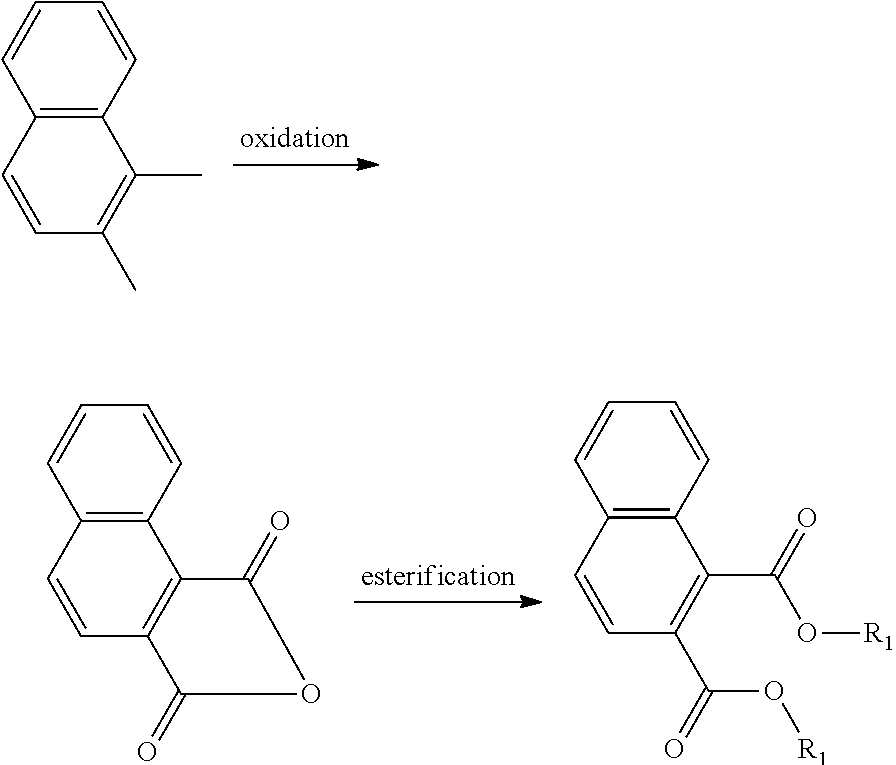
C00014
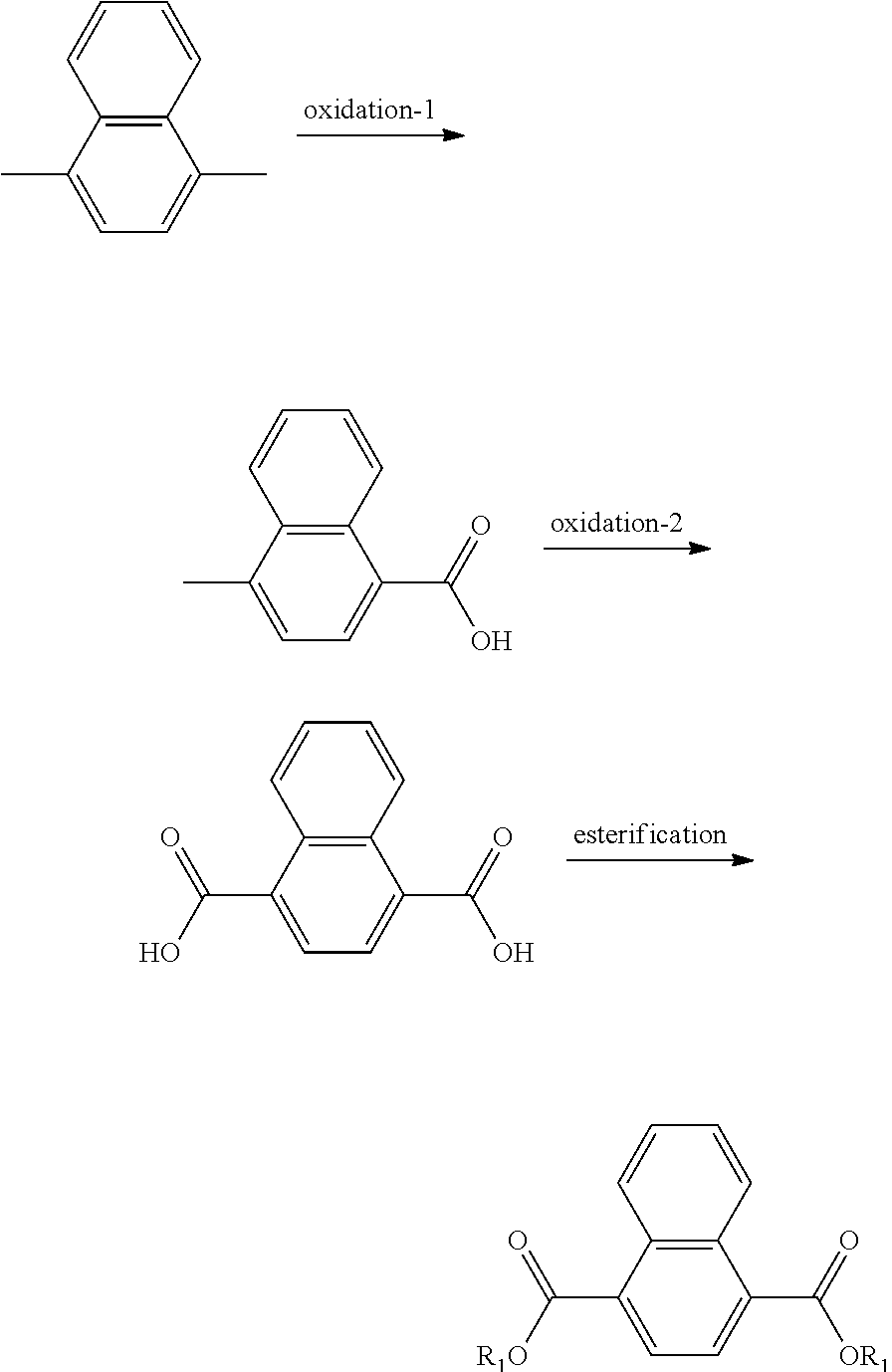
C00015
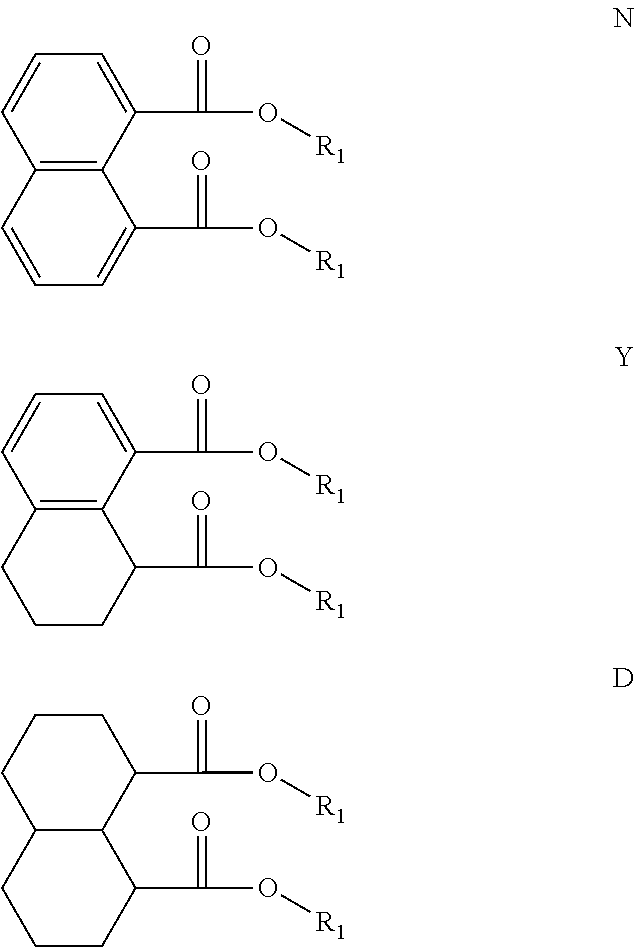
C00016
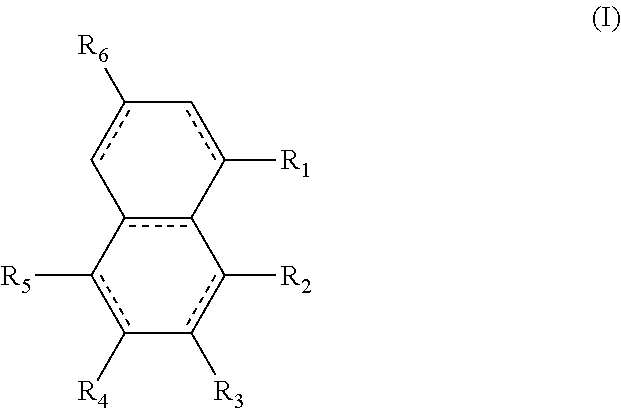
C00017
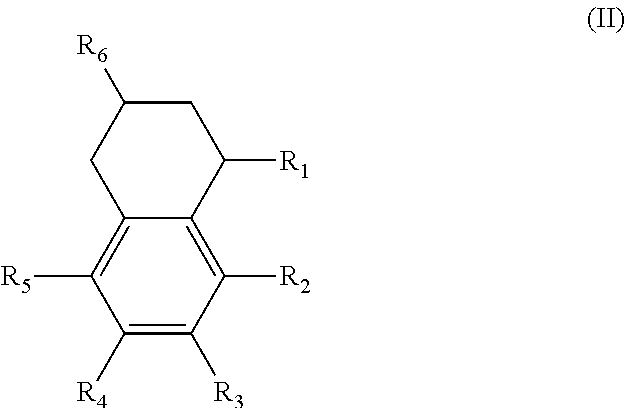
C00018
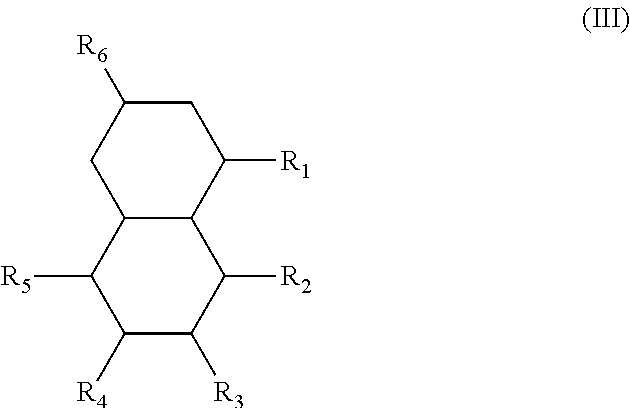
C00019

C00020
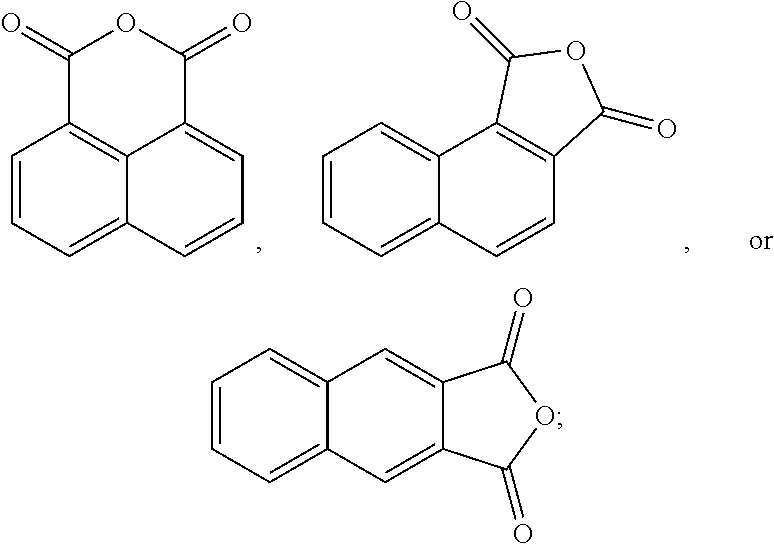
C00021

C00022
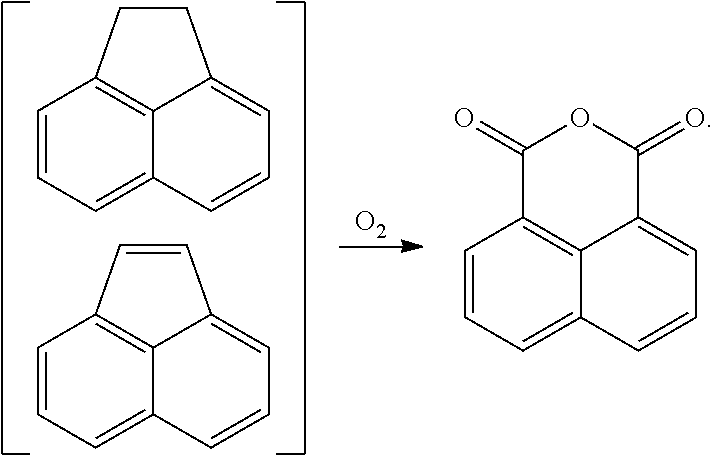
C00023
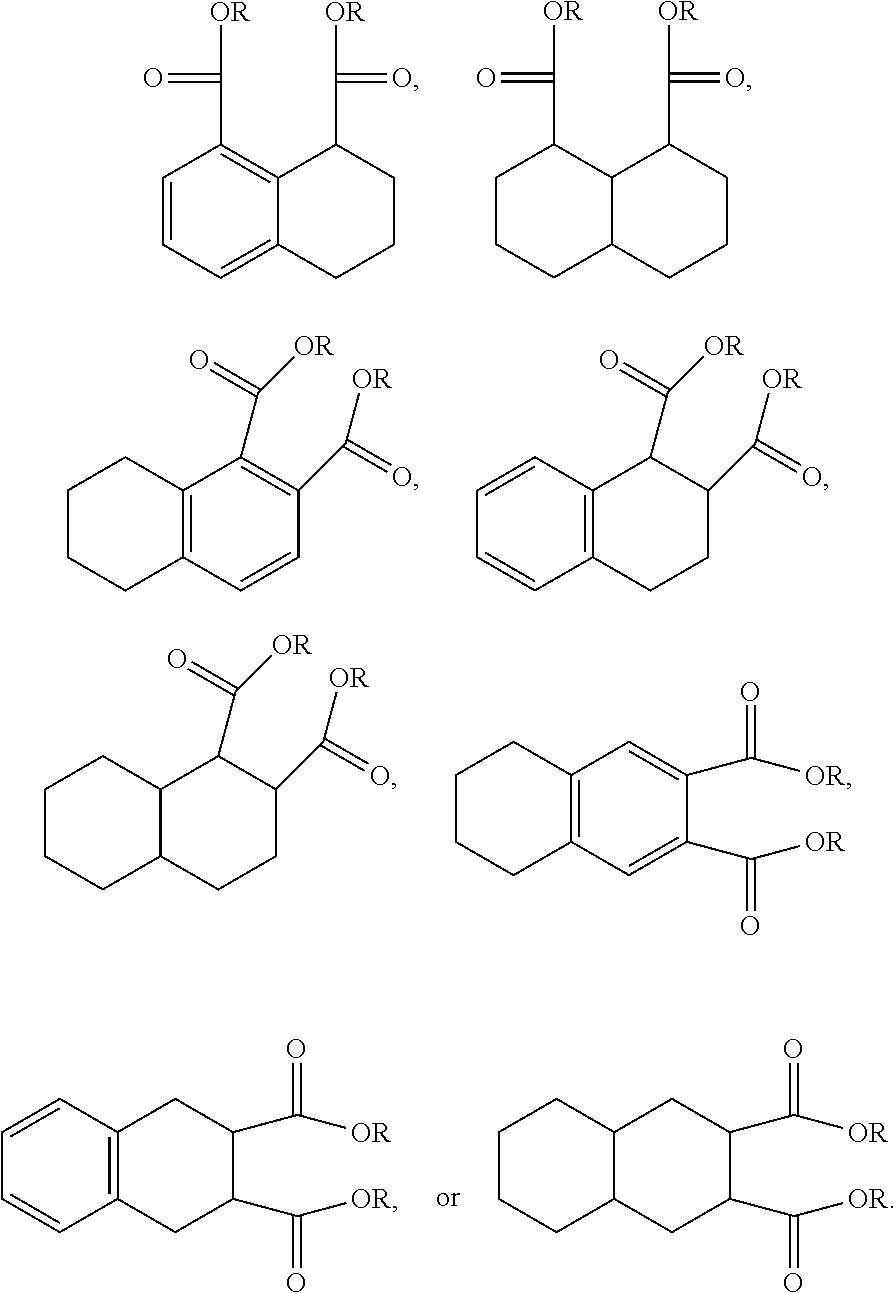
C00024

C00025

C00026
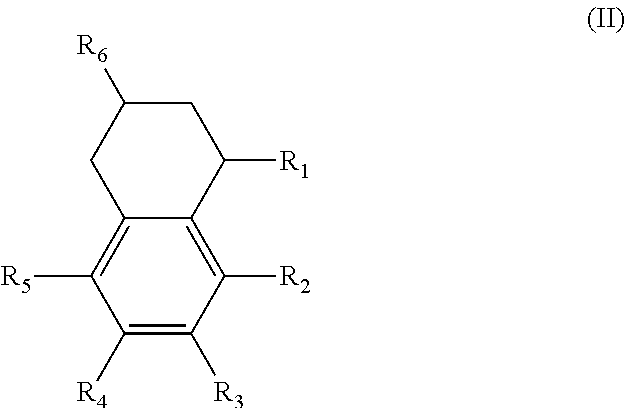
C00027
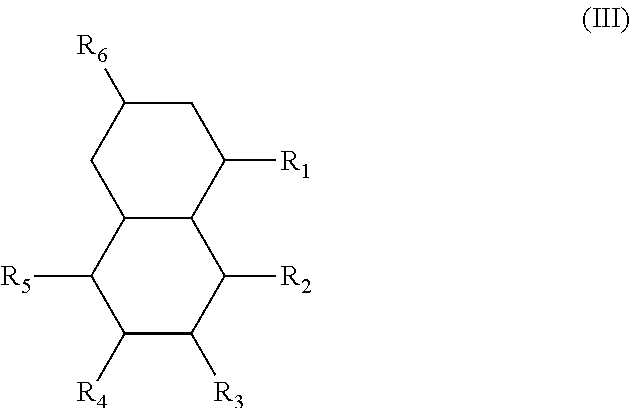
C00028
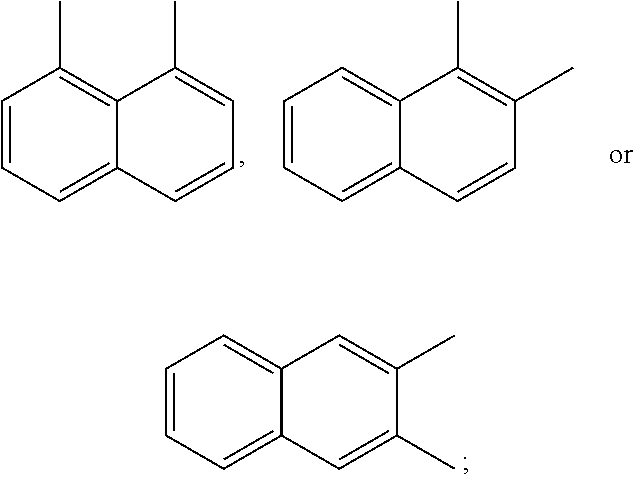
C00029
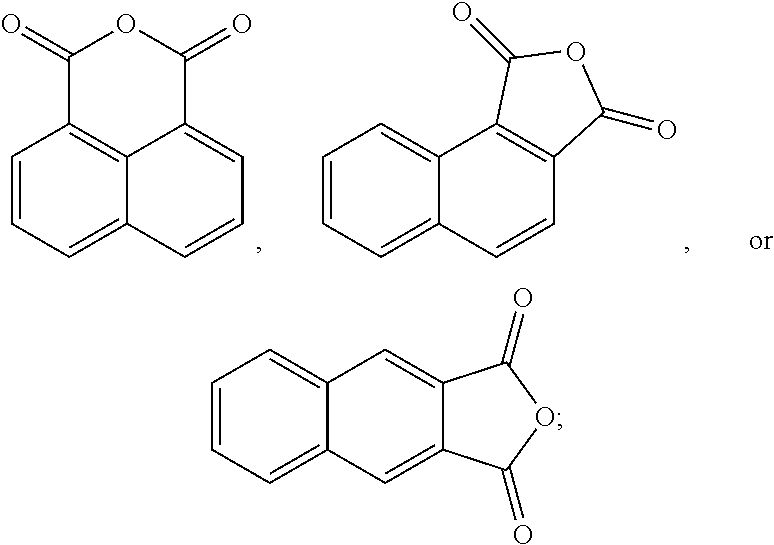
C00030
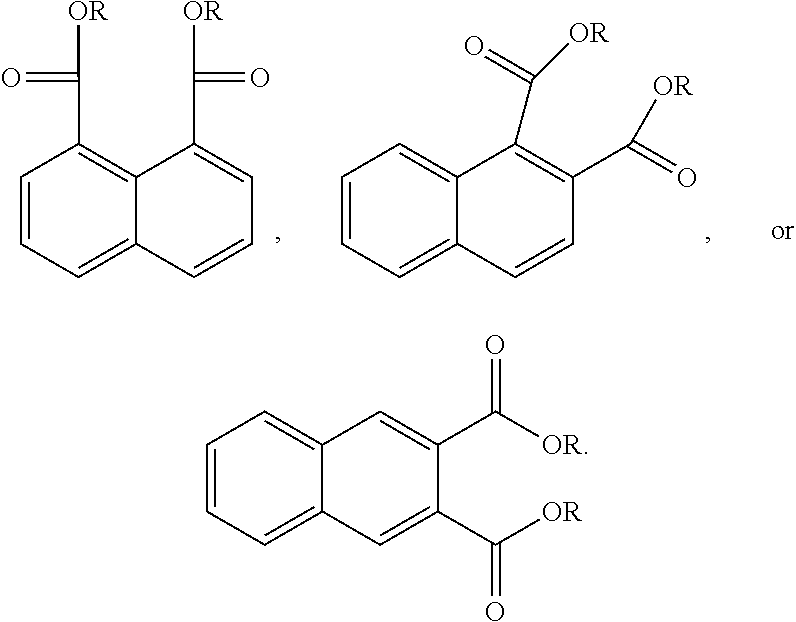
C00031
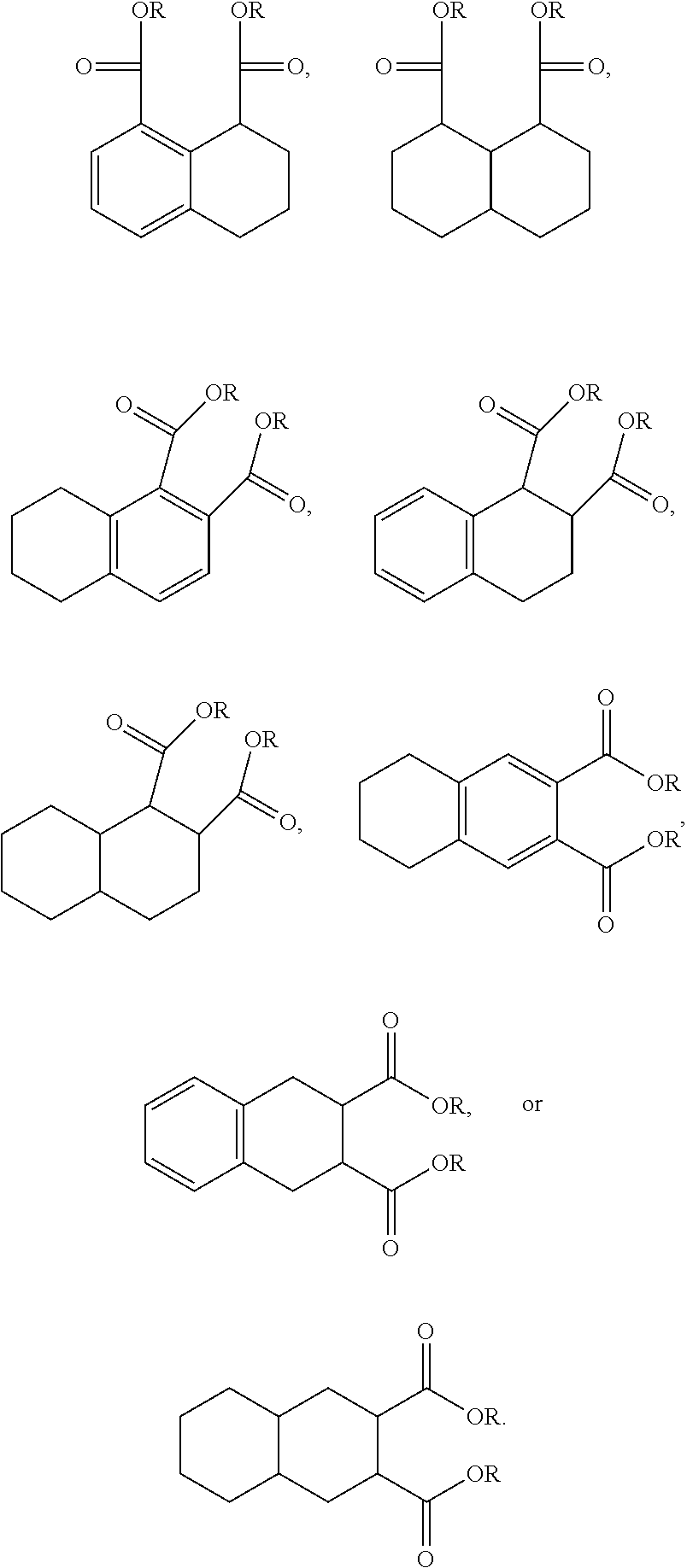
C00032

C00033

C00034

C00035

C00036

C00037
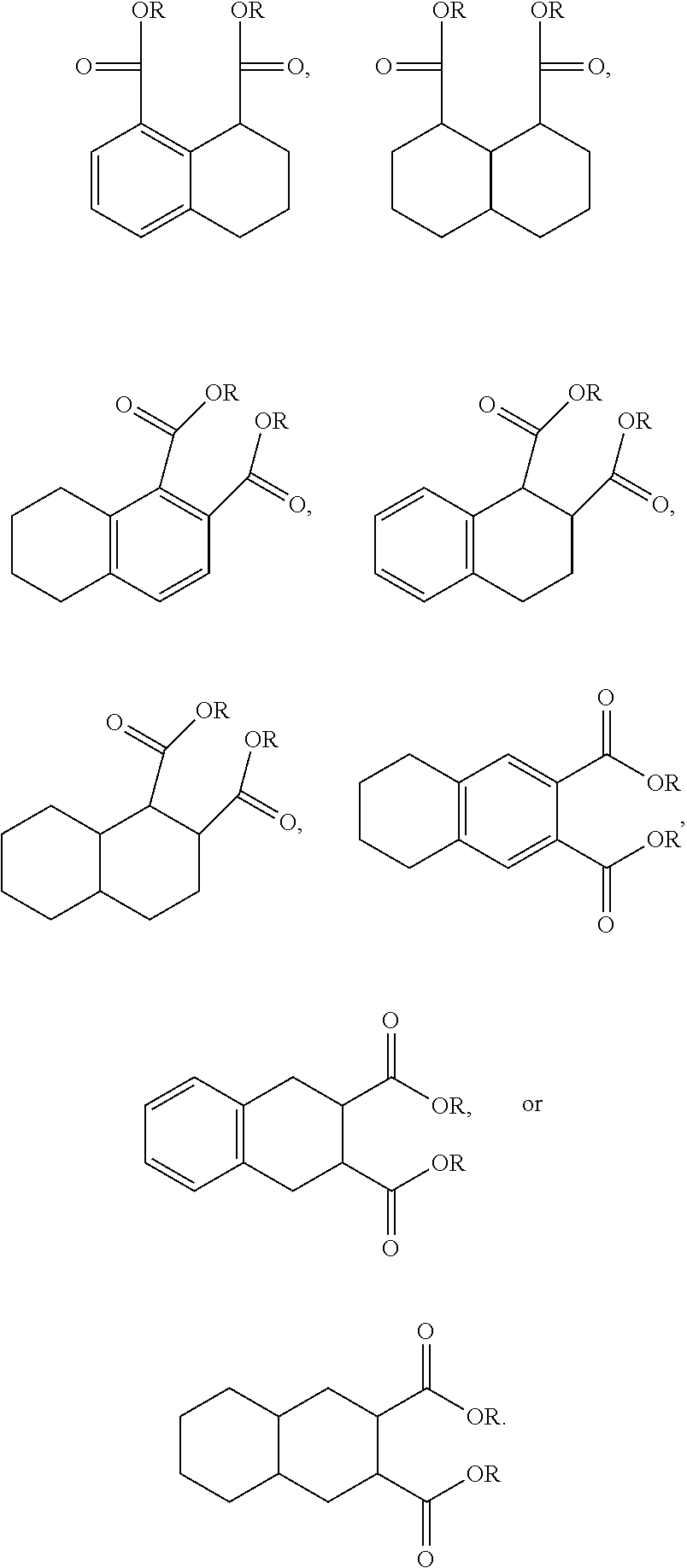
D00001
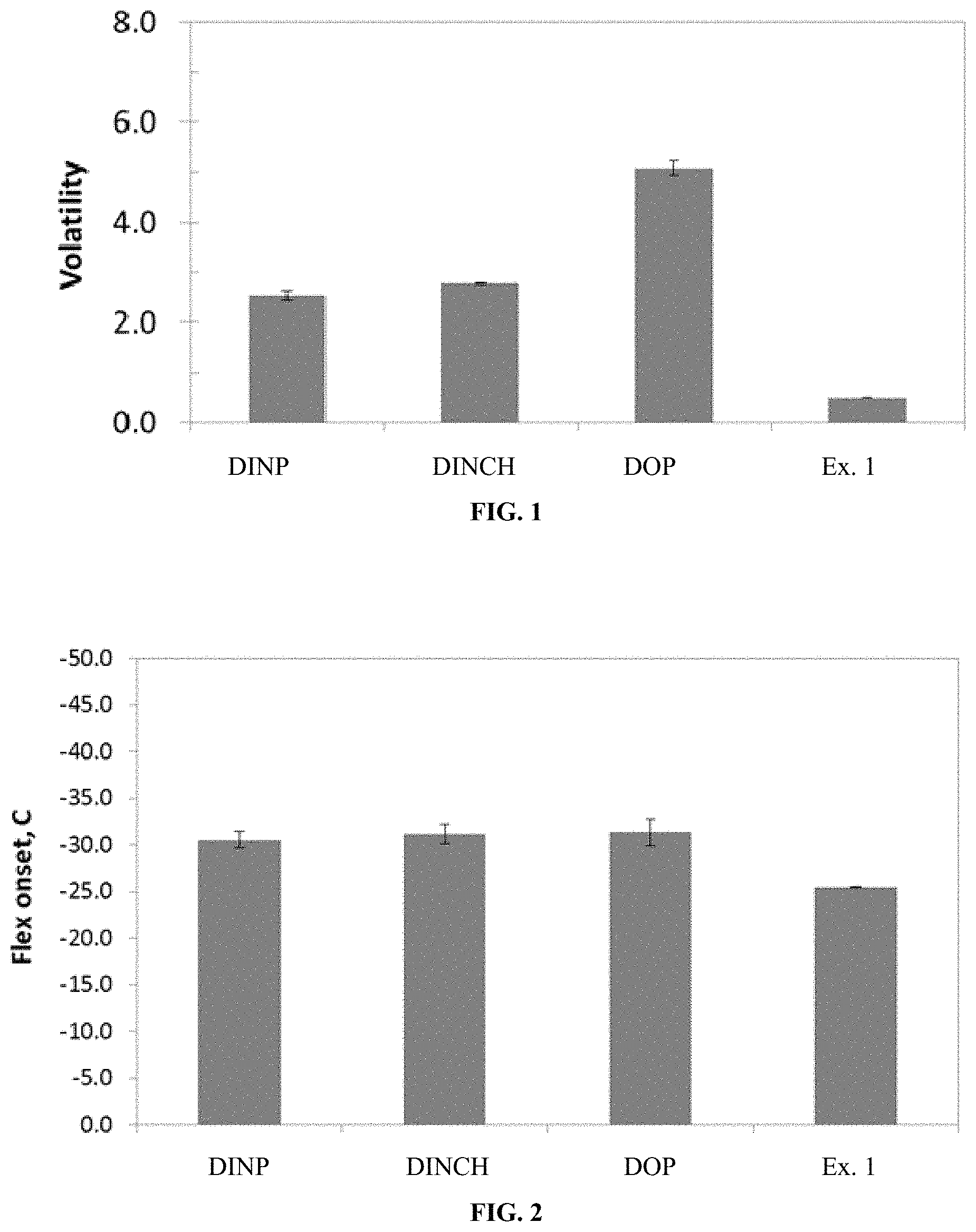
D00002
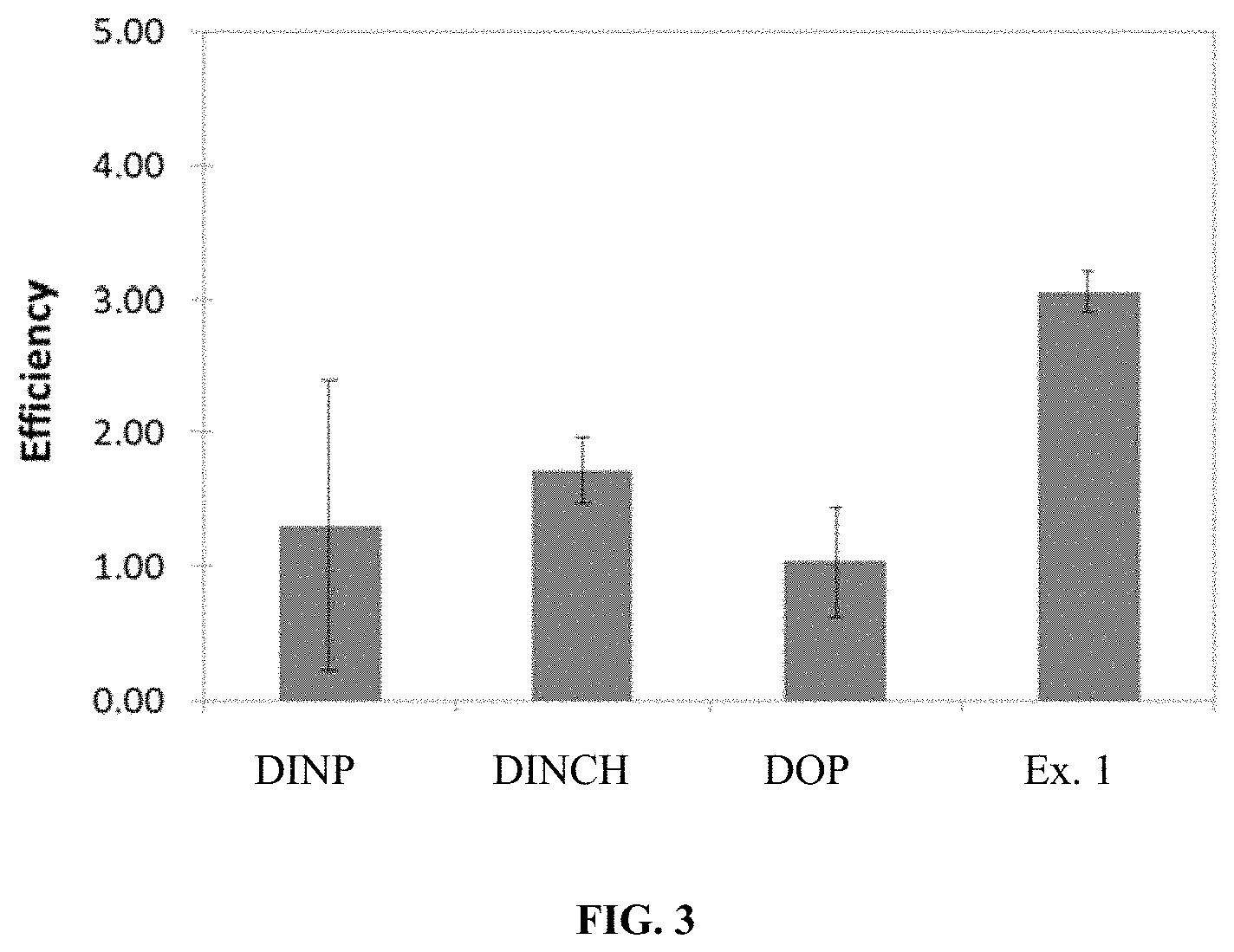
XML
uspto.report is an independent third-party trademark research tool that is not affiliated, endorsed, or sponsored by the United States Patent and Trademark Office (USPTO) or any other governmental organization. The information provided by uspto.report is based on publicly available data at the time of writing and is intended for informational purposes only.
While we strive to provide accurate and up-to-date information, we do not guarantee the accuracy, completeness, reliability, or suitability of the information displayed on this site. The use of this site is at your own risk. Any reliance you place on such information is therefore strictly at your own risk.
All official trademark data, including owner information, should be verified by visiting the official USPTO website at www.uspto.gov. This site is not intended to replace professional legal advice and should not be used as a substitute for consulting with a legal professional who is knowledgeable about trademark law.